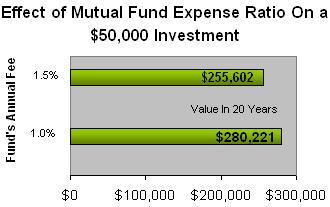
Why Mutual Fund Expense Ratios Matter.
How 0.5% In Higher Fees Can Cost You $25,000
12/23/03
Do you ever check your mutual fund’s expense ratios? Well,
you should because one study
shows that there’s an 89% chance that your funds will under-perform
if their expense ratios are above average. We'll also show
you that switching to a fund with an expense ratio that is
0.5% lower than your current fund can save you $25,000 or
more over time.
Standard & Poor’s recently did a study
that showed that "on average, funds with lower expense
ratios have outperformed their more expensive peers in eight
out of the nine domestic fund style categories over a one,
three, five, and ten-year annualized basis." In other
words, 89% of the time, funds with expense ratios lower than
their peers outperform those with higher expense ratios. A
lower expense ratio does not guarantee better performance,
but the study shows that choosing funds with low expense ratios
increases your odds of success. And isn't investing all about
putting the odds in your favor?
But let’s just ignore the fact that funds
with lower expense ratios tend to outperform those with high
expense ratios. Let’s assume that we have two funds that perform
the same before expenses, but one has an expense ratio of
1.5% and the other has an expense ratio of 1.0%. What kind
of difference can a half of one percent make? Over time it
can make a big difference.
As an example, let’s assume $50,000 is invested
in the two mutual funds for ten years. The fund with the lower
expense ratio would have earned over $5,000 more. After twenty
years, the difference grows to nearly $25,000. An amount equal
to almost one half of your initial investment would be saved
with the mutual fund with the lower expense ratio. So who
says a lousy half a percent doesn't amount to anything?

Don’t compare apples
to oranges.
One thing to keep in mind is that you must
compare mutual fund expense ratios with other mutual funds
in the same category. This is because some
types of mutual funds (such as international stock funds)
will almost always have higher expense ratios than other types
of funds (such as index funds). Just make sure to compare
index funds versus other index funds and international funds
versus other international funds.
So how do you find out if the mutual funds
you are interested in have expense ratios lower than their
peers? With the Internet, it's easy. You could go to Yahoo
Finance’s mutual fund “Profile” pages or Morningstar.com ‘s
“Fees & Expenses” section for the funds in question. Because
web pages may change over time, just drop us a line if you
have trouble locating this information. We'll quickly point
you in the right direction because we are very familiar with
this type of analysis. It’s just one of the many characteristics
we look for when searching for the mutual funds to recommend
to the subscribers of our investment newsletter.
-Rex M. Jacobsen
Sr. Editor
This article may be re-published as long as the following
resource box is included at the end of the article and as long as you link to
the URL mentioned in the resource box:
Article by Rex M. Jacobsen, Sr. Editor of the investment newsletter
Beat The Stock Market.com.
Since 1998, the company's model portfolio has achieved a return of
31.9% per year. The company's web site can be found at
http://www.BeatTheStockMarket.com.
|




